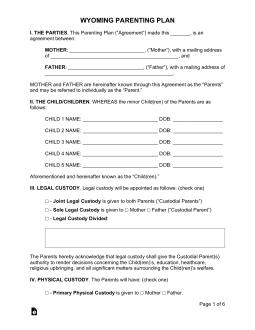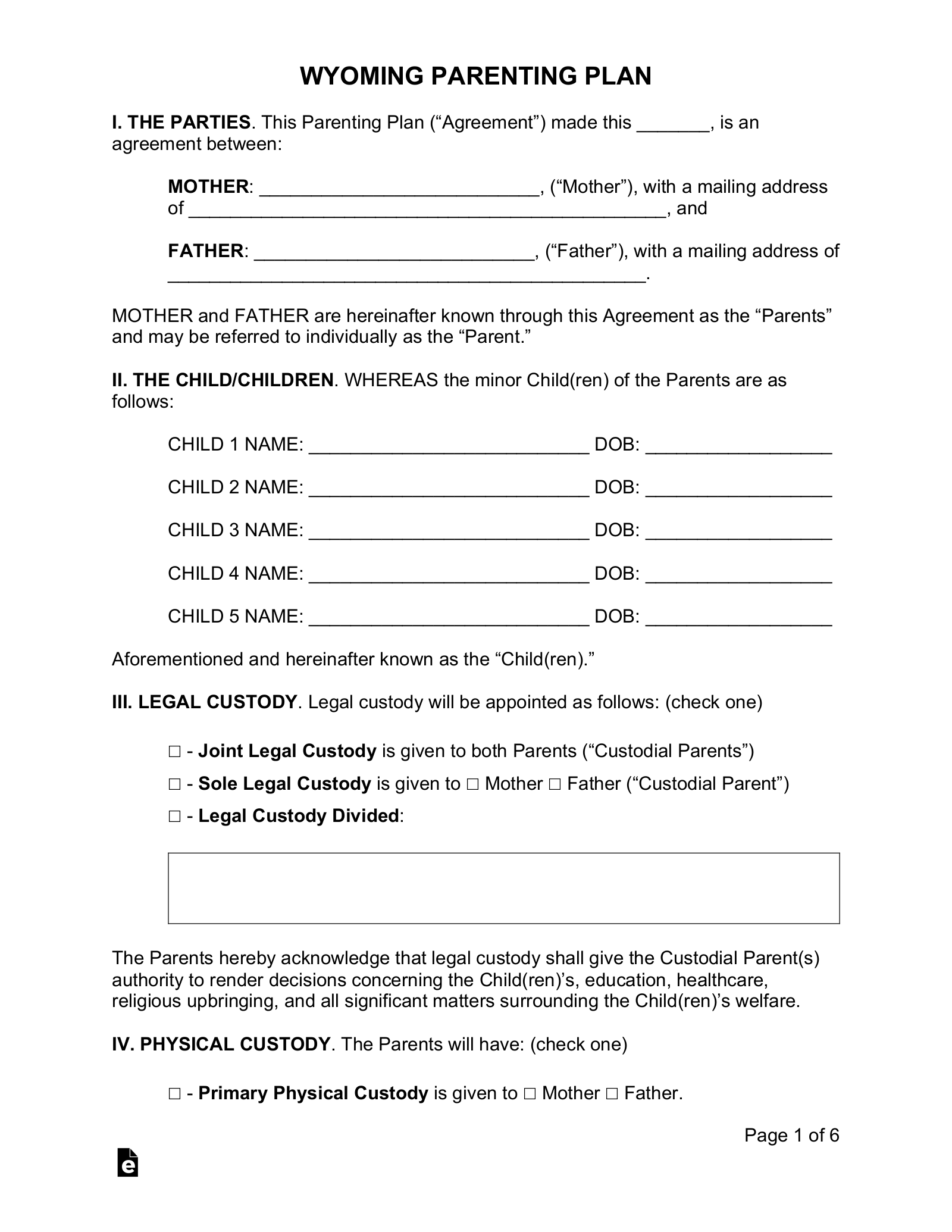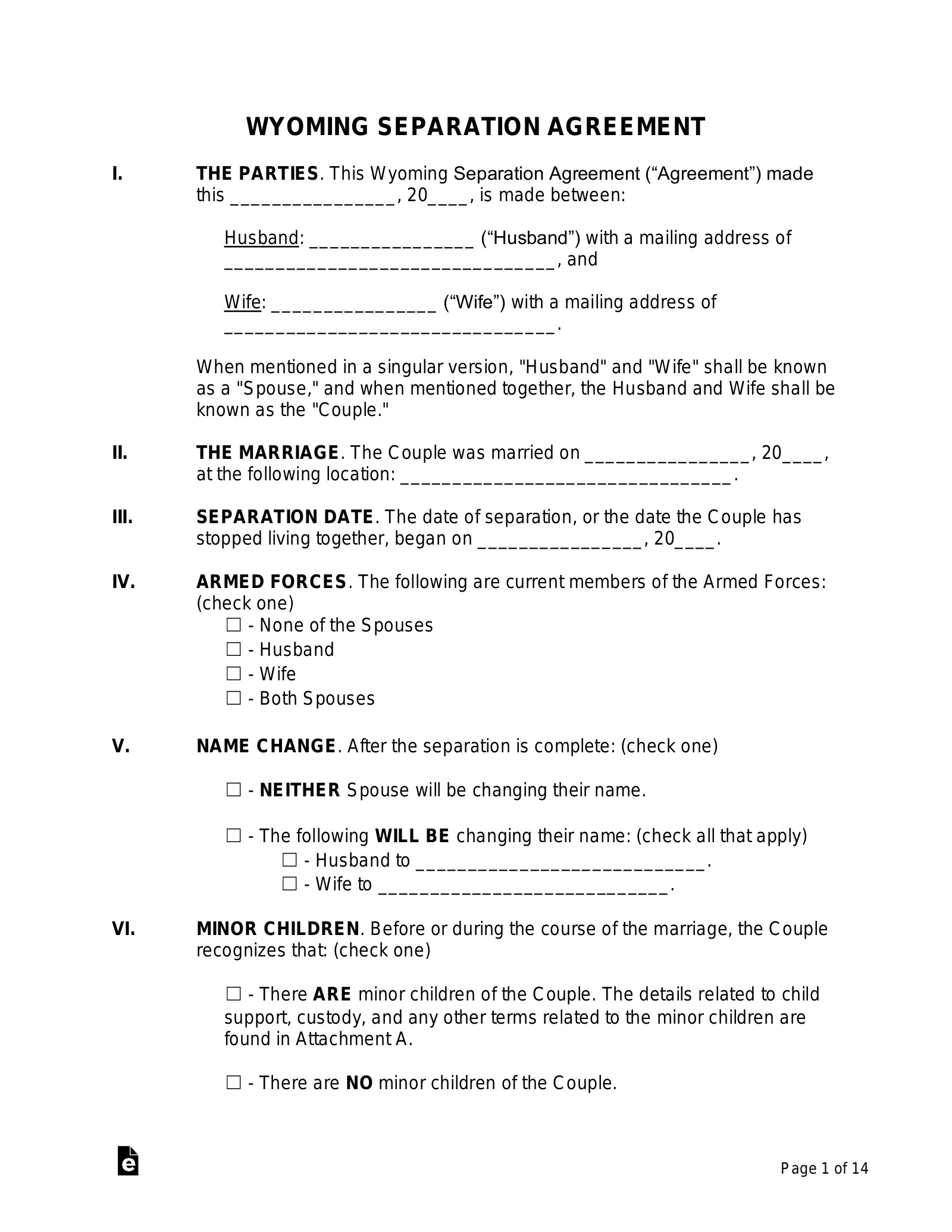Updated September 25, 2023
A Wyoming custody agreement, also known as a parenting plan, outlines the parental rights and responsibilities regarding a child whose parents are unmarried or in divorce proceedings. The process can occur on its own or in divorce proceedings. The Wyoming court offers a detailed step-by-step procedure to file for custody.
Child Custody Factors
The Wyoming court prioritizes the child’s best interests when determining custody arrangements. It will review the following criteria:
- Each parent’s ability to respect and support the child’s relationship with the other parent;
- Each parent’s ability to sufficiently provide care, food, and housing for the child;
- Each parent’s mental and physical health;
- The child’s relationships with each parent; and
- The geographic locations of each parent’s home.
Table of Contents |
How to File for Custody in Wyoming
1. Agree on a Parenting Plan
Prior to beginning the custody process in court, parents should try to agree on the terms of custody and create a parenting plan together. It should outline their plans for scheduling, visitation, childcare responsibilities, parental rights, and more. If parents are able to reach an agreement, the court is likely to approve those terms as long as they are determined to be in the child’s best interest.
2. Calculate Child Support
Use the state’s Child Support Guideline Calculator to estimate how much child support may be ordered by the court based on statutory guidelines. Some factors that determine child support obligations include the net monthly income of both parents, the number of children, and the number of overnights the child spends with each parent.
3. Complete and File Required Forms
Complete all of the following required forms. They should all be signed, notarized, and photocopied (make two copies each).
- Civil Cover Sheet
- Petition to Establish Custody, Visitation, and Child Support
- Summons
- Confidential Statement of the Parties for Child Support Order
- Acknowledgment and Acceptance of Service
- Confidential Financial Affidavit
- Affidavit for Order Establishing Custody, Visitation, and Child Support Without Appearance of Parties
- Order Establishing Custody, Visitation, and Child Support
- Order for Income Withholding
- Income Withholding for Support
File the paperwork with the district court local to the child’s permanent residence. Some courts have additional mandatory paperwork, so checking in with the local clerk before filing any documents is essential. Pay the local filing fee, if applicable.
The clerk will sign and stamp the Summons before returning it to the person who filed it, who is known as the petitioner. They will also return the two photocopies of each file-stamped document to the petitioner.
4. Serve Respondent
Within 90 days of filing, the petitioner must serve the respondent (the other party in the custody case) with file-stamped copies of the Petition to Establish Custody, Visitation, and Child Support, Confidential Statement of the Parties for Child Support Order, and Summons.
The petitioner is advised to utilize the services of their local sheriff to serve these forms on the respondent ($50 fee). In this instance, the sheriff will complete the “Return” document on the last page of the Summons. If, however, the petitioner must serve the respondent personally, the respondent must also complete an Acknowledgment and Acceptance of Service.
The respondent has 20 days (Wyoming residents) or 30 days (out-of-state residents) to file a Response to Petition to Establish Custody, Visitation, and Child Support or a Response and Counterclaim to Petition to Establish Custody, Visitation, and Child Support with the court clerk. The respondent then must serve the petitioner with their file-stamped Response.
Within 30 days of the respondent’s deadline to serve the petitioner with their Response, both parties must serve the Initial Disclosures on each other.
5. Initiate Proceedings
This step varies depending on whether the respondent files a Response.
5a: Respondent filed a Response, and both parties agree on all issues of the case
Both parties file a Confidential Financial Affidavit (and supporting attachment), Affidavit for Order Establishing Custody, Visitation, and Child Support Without Appearance of Parties, Order Establishing Custody, Visitation, and Child Support, Order for Income Withholding, and Income Withholding for Support. They must also send each other copies of each filed document.
The petitioner is responsible for providing the court with two envelopes addressed and stamped to the petitioner and the respondent. The court will use these to mail the Order Establishing Custody, Visitation, and Child Support to each party.
5b: Respondent did not file a Response
The petitioner completes and signs an Application for Entry of Default and an Affidavit in Support of Default. They file these documents and a blank Entry of Default. If the clerk approves the paperwork, they will sign the Entry of Default.
Next, the petitioner completes and files the Confidential Financial Affidavit (and supporting attachment), Affidavit for Order Establishing Custody, Visitation, and Child Support Without Appearance of Parties, Order Establishing Custody, Visitation, and Child Support, Order for Income Withholding, and Income Withholding for Support.
5c: Respondent filed a Response, and both parties do not agree on all issues of the case
The petitioner has 20 days from receiving the respondent’s Response and Counterclaim to Petition to Establish Custody, Visitation, and Child Support to file a Reply to Counterclaim with the court and serve it to the respondent.
6. Attend Hearing or Trial (if necessary)
If the judge warrants a hearing is necessary before signing the Order Establishing Custody, Visitation, and Child Support, the petitioner files a Request for Setting and Order Setting Hearing with the clerk. The court will select a hearing date and time.
When the respondent has filed a counterclaim, the petitioner writes in “trial” for the type of hearing on the Request for Setting and files an Order Setting Divorce Trial and Requiring Pretrial Statements instead of the standard Order Setting Hearing form. The court will schedule the trial date and time. Both parties file Pretrial Disclosures with the court at least 30 days before trial.
7. Custody Arrangement Finalized
The judge finalizes the custody agreement when they sign, and the court mails the Order Establishing Custody, Visitation, and Child Support to the parents.
Custody Laws
- Child or spousal abuse: § 20-2-201(c)
- Child support: Title 20, Chapter 2, Article 3, Title 20, Chapter 6
- Child’s best interests: § 20-2-201(a)
- Desertion of Spouse or Children: Title 20, Chapter 3
- Emergency custody: § 20-5-304
- Grandparent visitation: § 20-7-101
- Medical support: Title 20, Chapter 2, Article 4
- Modification: § 20-2-204(c)
- Parenting classes: § 20-2-201(f)
- Records access: § 20-2-201(e)
- Temporary custody of children: § 20-2-112(b)
- Uniform Child Custody Act: Title 20, Chapter 5
- Visitation: § 20-2-202
Related Forms




